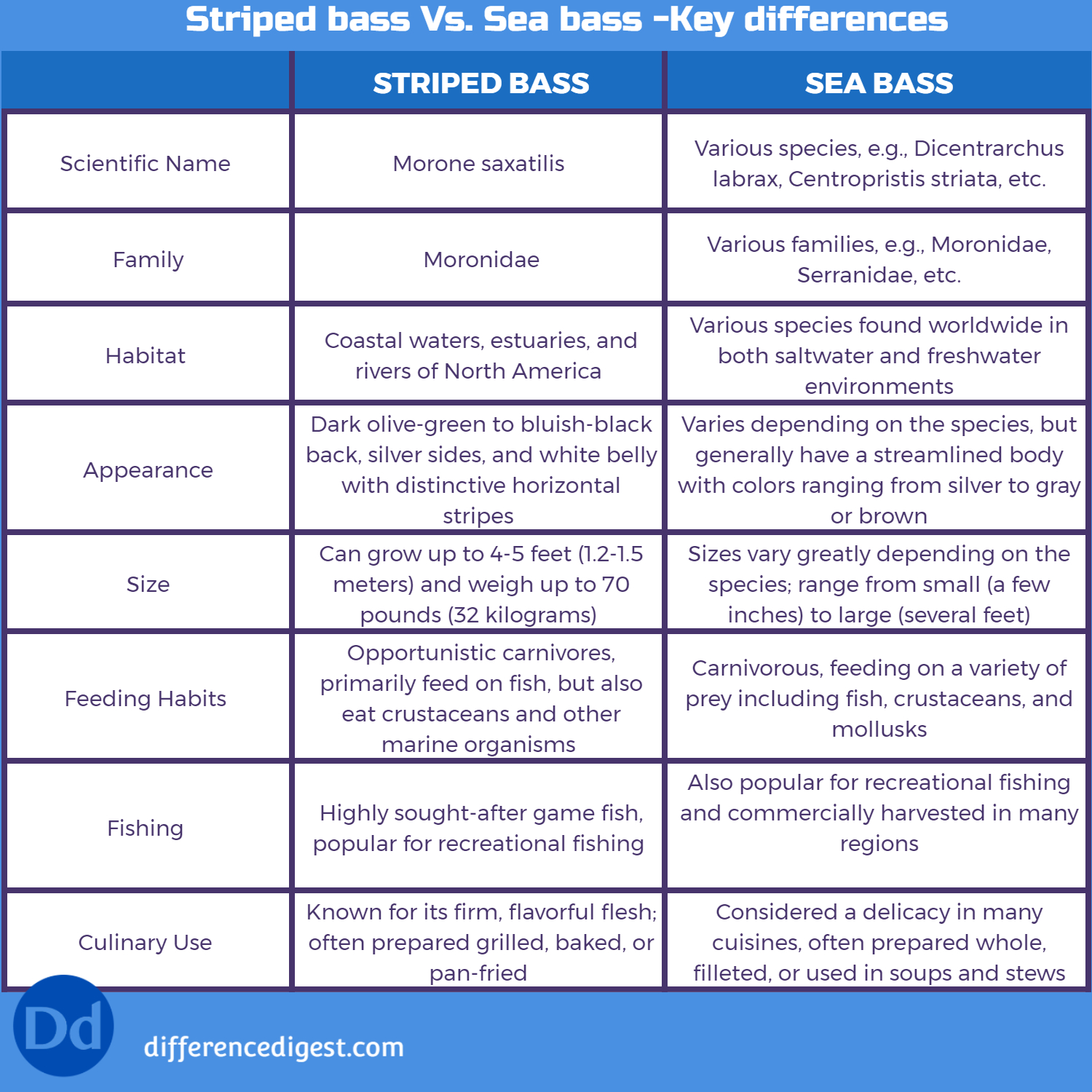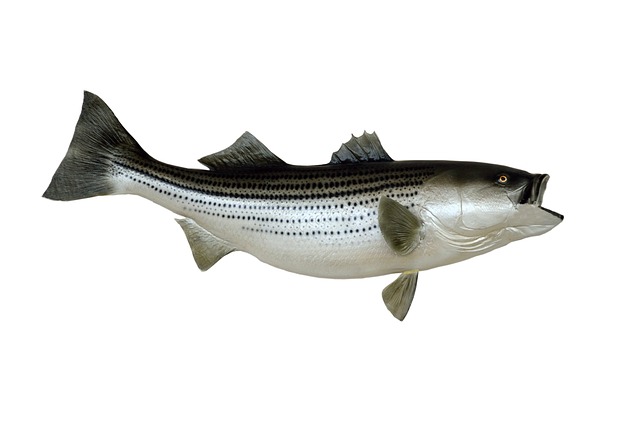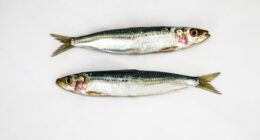Striped bass has a mild and delicate flavor with slightly sweet undertones, making it a versatile choice for various culinary preparations. Sea bass offers a richer and more savory taste with buttery textures that make it incredibly satisfying on the palate.
Striped bass

(Image by zygplater0 from Pixabay)
Striped bass, also known as “stripers,” are a prized catch for anglers and a culinary delight for seafood enthusiasts. These fish are native to the Atlantic Coast of North America, from Nova Scotia all the way down to Florida. With their sleek silver bodies adorned with dark horizontal stripes, striped bass are quite the sight to behold.
Found primarily in saltwater environments, striped bass can also be found in freshwater lakes and rivers during certain times of the year. They have an impressive ability to adapt to different habitats, making them versatile creatures indeed.
Now let’s talk about taste – one bite of striped bass will transport your taste buds into pure bliss! The meat is firm yet tender with a mild flavor that is often described as slightly sweet and buttery. Its delicate texture lends itself well to various cooking methods such as grilling, baking, or even pan-searing.
When it comes to nutrition, striped bass is packed with essential omega-3 fatty acids which are beneficial for heart health and brain function. It’s also a great source of protein while being relatively low in calories and saturated fat.
In terms of appearance and size, adult striped bass can grow up to three feet long and weigh anywhere between 5-30 pounds. Their large mouths filled with sharp teeth make them formidable predators in their aquatic domain.
So whether you’re reeling one in on your fishing rod or savoring a deliciously cooked fillet at your favorite seafood restaurant, discover the wonders of this magnificent fish – the mighty striped bass!
Sea bass

(photo by Peter Handke on Flickr)
Sea bass is a popular fish known for its delicate flavor and versatility in the kitchen. It belongs to the family of Percichthyidae, which includes various species found in different parts of the world. With its white flesh and mild taste, sea bass has become a favorite among seafood lovers.
One key difference between sea bass and striped bass lies in their habitat. Sea bass can be found in both saltwater and freshwater environments, depending on the species. They are commonly found along coastal areas, estuaries, and rocky reefs. This wide range allows them to adapt to various conditions.
When it comes to taste, sea bass offers a subtle flavor that is often described as buttery or sweet. Its tender flesh can be cooked using various methods such as grilling, baking, or pan-frying. The mild flavor makes it an excellent choice for those who prefer a more delicate taste.
In terms of nutrition, sea bass is low in fat but high in protein content. It also contains essential nutrients like omega-3 fatty acids and vitamin D. These nutrients are beneficial for heart health and overall well-being.
Cooking sea bass requires some care to bring out its best flavors. Grilling or roasting with simple seasonings like lemon juice, garlic, and herbs can enhance its natural taste without overpowering it.
To sum up briefly (without drawing any conclusions), sea bass is a versatile fish with a delicate flavor that appeals to seafood enthusiasts worldwide!
Striped bass Vs. Sea bass – Key differences
When it comes to distinguishing between striped bass and sea bass, there are several key differences that set them apart. First and foremost, their appearance varies greatly. Striped bass have a distinctive pattern of dark stripes running along their silvery sides, while sea bass typically display a more solid coloration, ranging from grayish-white to brown.
In terms of habitat, striped bass prefer the waters along the Atlantic coast of North America, from Canada down to Florida. Sea bass can be found in various regions around the world, including the Mediterranean Sea and the Pacific Ocean. This difference in habitat contributes to variations in taste as well.
Speaking of taste, many seafood lovers have differing preferences when it comes to these two fish. Striped bass has a richer flavor with hints of sweetness. On the other hand, sea bass is known for its delicate yet savory taste.
When it comes to culinary preparation, both striped bass and sea bass lend themselves well to a variety of cooking methods such as grilling or baking. However, due to its firm texture and larger size potential (striped bass can grow significantly bigger), some may find striped bass easier to work with in certain recipes.
While both types of fish offer unique qualities on their own merits, it ultimately boils down to personal preference whether you prefer the boldness of striped bass or the subtlety of sea bass.

The difference in habitat between striped bass and sea bass
The habitat of striped bass and sea bass differ significantly, contributing to their distinct characteristics. Striped bass, also known as rockfish, are primarily found in North America along the Atlantic coast. They inhabit both freshwater and saltwater environments, such as rivers, estuaries, bays, and coastal areas. These resilient fish can tolerate a wide range of salinities and temperatures.
On the other hand, sea bass is a term used to describe various species of fish that belong to the Serranidae family. They are commonly found in tropical or subtropical regions around the world. Sea bass prefer warm waters with rocky or coral reefs where they can seek shelter and feed on smaller organisms like crustaceans and small fish.
While striped bass thrive in cooler waters with strong currents for spawning purposes, sea bass prefer calmer waters near structures where they can hide from predators. The contrasting habitats contribute to differences in their physical appearance, behavior patterns, feeding habits, and overall adaptability to different environmental conditions.
Understanding these variations in habitat helps us appreciate how these two distinct species have evolved differently over time to survive within their respective ecosystems. Whether you’re an angler seeking a thrilling catch or simply enjoy indulging in delicious seafood dishes – knowing these distinctions adds depth to your experience!
The difference in taste between striped bass and sea bass
One of the key differences between striped bass and sea bass lies in their taste. While both fish have a mild flavor, they do differ slightly in terms of their overall taste profile.
Striped bass, also known as rockfish, has a rich and buttery flavor with a hint of sweetness. Its meat is firm and succulent, making it perfect for grilling or pan-searing. The flesh is white when cooked and has a delicate texture that melts in your mouth.
On the other hand, sea bass offers a more delicate and subtle taste. It has a clean flavor with notes of sweetness and nuttiness. The flesh is tender yet flaky, lending itself well to various cooking methods such as steaming or baking.
While both types of bass are delicious in their own right, some people prefer the slightly stronger flavor of striped bass for heartier dishes like fish tacos or chowders. Sea bass’s milder taste makes it an excellent choice for those who enjoy lighter flavors or want to experiment with different seasoning combinations.
Deciding which one you prefer comes down to personal preference and the specific dish you’re preparing. So why not try them both? Experimenting with new flavors can be an exciting culinary adventure!
How to cook striped bass and sea bass
When it comes to cooking striped bass and sea bass, there are endless possibilities. Both fish have a mild flavor that pairs well with a variety of ingredients and cooking methods.
For striped bass, grilling is a popular choice. The firm flesh holds up well on the grill, creating a delicious smoky flavor. You can marinate the fish in your favorite seasonings or simply brush it with olive oil, salt, and pepper before grilling. Another option is baking the striped bass in the oven with lemon slices and fresh herbs for an easy yet flavorful meal.
Sea bass is equally versatile in the kitchen. Pan-searing sea bass creates a crispy skin while keeping the flesh moist and tender inside. You can also try steaming sea bass fillets with ginger, garlic, and soy sauce for an Asian-inspired dish that bursts with flavors.
Both types of fish can be used in soups or stews too. Striped bass adds depth to chowders while sea bass brings its delicate taste to bouillabaisse recipes.
How you cook striped bass or sea bass depends on your personal preference and culinary creativity!
What are other names for striped bass?
Striped bass, also known as Morone saxatilis in the scientific world, goes by different names depending on where you are. Along the Atlantic coast of North America, it is commonly referred to as “striper.” In the Chesapeake Bay region, locals affectionately call it “rockfish,” which reflects its preference for rocky habitats. Up north in New England, you might hear people calling it a “linesider” due to the distinct dark stripes that run along its body.
If you venture down south towards Florida and the Gulf of Mexico, striped bass takes on another alias – “striped sea bass.” This name helps distinguish it from other fish species like black sea bass or white seabass found in those waters.
Interestingly enough, striped bass can even be called “strippers” or “slammers” by avid anglers who enjoy catching this exciting game fish. These nicknames reflect both their popularity among fishermen and their tendency to put up a good fight when hooked.
| DIFFERENT NAMES FOR BASS | ||
|---|---|---|
| Striper | Linesider | Greenhead |
| Rockfish | Linesides | Rock |
No matter what you choose to call them – stripers, rockfish, linesiders – one thing remains constant: these sleek and powerful fish capture the hearts (and taste buds) of many seafood enthusiasts around the world!
Featured Image By – Paul Brennan from Pixabay









